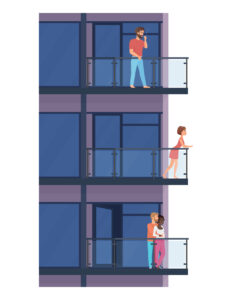What to consider before changing lanes
by RUSHI SHAH
While a widespread vaccine has provided some hope for recovery, most hotel owners will likely continue to struggle with uncertain demand and disrupted cash flow for the foreseeable future. Facing this predicament, some hoteliers have started to question whether their properties will recover in time or if they should take a more drastic approach and convert their outdated, unbranded, or exterior corridor hotels into apartments or assisted-living facilities. For many, this adaptive reuse is a viable strategy. While hospitality and multifamily assets do have a lot in common, there are key differences, especially when it comes to financing. Let’s explore.
EXPECTED REVENUE
Although a standard multifamily unit generates roughly 2.5 times less revenue per unit than that of a hotel room, it typically throws 60 percent of the revenue to the bottom line, compared to 35 percent for hotels. This supports considering a multifamily conversion because the revenue derived from annual leases is stickier than what is generated from the more transient hotel business. Multifamily tenants are also more likely to renew their lease when it matures annually, creating a more predictable cash flow stream.
Property taxes are another factor that make converting to multifamily attractive. Historically, local tax authorities have been less likely to increase taxes on multifamily assets than on hospitality assets. As local governments search for additional revenue streams to ease their current cash flow strains, hotels will likely remain more vulnerable to tax hikes.
 CONVENTIONAL AND AGENCY FINANCING OPTIONS
CONVENTIONAL AND AGENCY FINANCING OPTIONS
Multifamily properties also score higher than hotels when it comes to available financing. Capital markets offer more depth in financing multifamily assets compared to independent hotels. Many lenders already offer specific programs to convert hotels to apartments or senior living facilities. Conventional financing mechanisms include bridge loans, either offered by debt funds or agency lenders with an exit into a Fannie Mae- or Freddie Mac-backed permanent loan or through balance sheet lenders looking at an exit into a permanent Commercial Mortgage Backed Securities (CMBS) loan. Multifamily assets also can benefit from additional government support through the U.S. Department of Housing and Urban Development (HUD). Most of these government-backed programs allow between a 75 percent to 85 percent loan-to-cost ratio, which means developers can fill larger portions of their capital stacks with cheaper debt capital. For example, the cost of capital for a bridge loan for a multifamily conversion can range from 4 percent to 7 percent with some or no recourse, compared to a simple hotel repositioning loan that costs 7 percent to 11 percent with some or no recourse. The cost of capital for permanent capital for a multifamily deal can range from 2.5 percent fixed for 35 years for a HUD loan to 3.5 percent fixed for 12 years with a 30-year amortization for an agency loan. While compelling from a pricing perspective, HUD loan transactions can be logistically challenging and often take four-to-six months to close. CMBS lenders also price effectively for multifamily loans, offering 10-year, fixed-rate, interest-only loans at interest rates from 3.5 percent to 4.25 percent. Preferred equity and mezzanine capital are other options to finance a conversion.
TO CONVERT OR NOT CONVERT
To know if a hotel is a good candidate for a conversion play, a hotelier must first analyze the local market to gauge demand for multifamily. Converting a hospitality asset to a multifamily or another use is a permanent decision. Therefore, it is extremely important to avoid jumping to a permanent conclusion based on temporary market conditions. If the hotel is no longer needed in that market or the property is obsolete compared to new supply and the potential renovation cost to make it competitive is prohibitive, then conversion may be an option. If conversion is not an answer, there are additional solutions that can get a hotelier to the other side of today’s turbulent waters, including bridge, rescue, and equity capital. Enlisting the expert help of a trusted intermediary who knows and has closed financing for both hotel and multifamily can help owners confidently weigh the pros and cons of all available options.
 Rushi Shah is principal and CEO of the commercial mortgage and real estate investment banking firm and AAHOA Allied Member Mag Mile Capital. As a leader in hospitality financing, Shah specializes in structuring and placing high-leverage, non-recourse bridge and permanent debt with cash out for full – and limited-service hotels nationwide. Since joining the firm’s predecessor, Aries Capital, in 2015, Shah has structured and closed hundreds of millions in financing for all property types. Shah has held previous positions at Northern Trust and has an MBA from the University of Chicago’s Booth School of Business.
Rushi Shah is principal and CEO of the commercial mortgage and real estate investment banking firm and AAHOA Allied Member Mag Mile Capital. As a leader in hospitality financing, Shah specializes in structuring and placing high-leverage, non-recourse bridge and permanent debt with cash out for full – and limited-service hotels nationwide. Since joining the firm’s predecessor, Aries Capital, in 2015, Shah has structured and closed hundreds of millions in financing for all property types. Shah has held previous positions at Northern Trust and has an MBA from the University of Chicago’s Booth School of Business.




